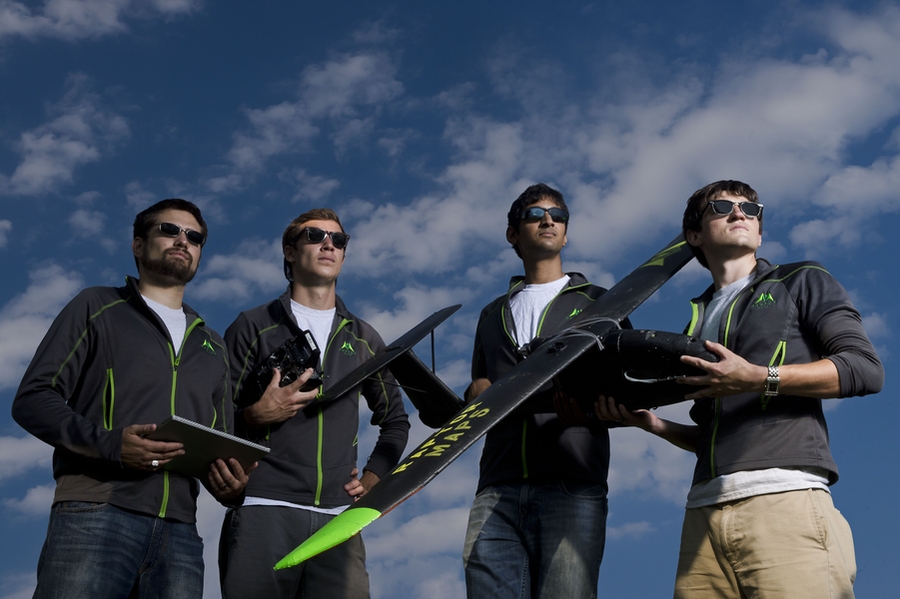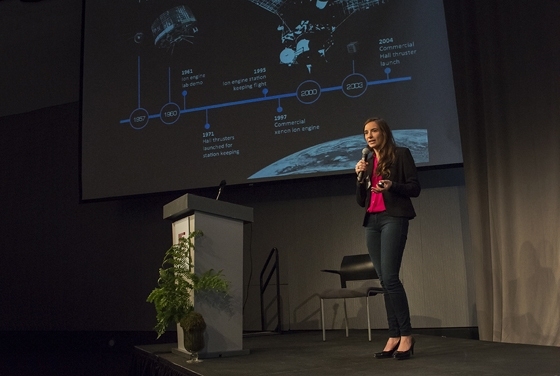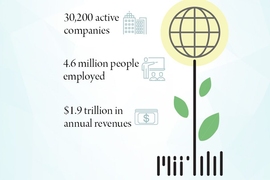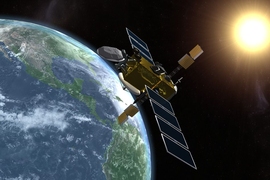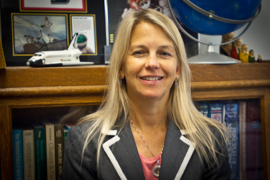“Students in AeroAstro don’t have to wait 30 years for the next Boeing aircraft to come out, or for NASA to send humans to Mars,” says doctoral candidate Edward Obropta ’13, SM ’15. The chief technology officer of a young drone technology company adds that he and his colleagues “see opportunities to do things today.”
Alumna Natalya Brikner PhD ’15, CEO of a satellite technology venture, agrees. She sees “space opening up to more people as the aerospace industry becomes more private.”
The “final frontier” has opened up, indeed, as the public can now fly commercially-available drones, access real-time satellite weather and navigation technologies, or even purchase tickets for a future Virgin Galactic suborbital flight. With such changes, MIT Department of Aeronautics and Astronautics (AeroAstro) students and alumni are finding themselves confronted with a range of unprecedented opportunities.
During the past century, MIT’s aerospace innovators have helped win the race to the moon, shaped the nation’s aviation industry, perfected technologies that keep the nation secure, and begun probing the deepest reaches of the universe. These days, thanks to advances in technology and manufacturing, the proliferation of aviation as a mode of passenger and cargo transport, and reductions in governments’ appetites for large-scale space programs like Apollo, AeroAstro innovators can start their own companies, create their own aviation designs, build their own rockets, and make an impact outside of government facilities and large aerospace firms.
Brikner, for example, and her business partner Louis Perna ’09, SM ’14, began Accion Systems Inc. in 2012. Their company is based on a technology they developed with AeroAstro associate professor Paulo Lozano in the Space Propulsion Laboratory — a compact, inexpensive, electric-based satellite thruster system. These tiny rocket motors will enable inexpensive microsatellites to accomplish work previously possible only with large, expensive satellites. As a result of this new technology, sophisticated space missions once exclusively the province of the government and large aerospace firms are now within reach of entrepreneurs like Brikner.
The challenge is getting this new technology from the lab to the marketplace, says Brikner. “I exhausted almost every startup resource MIT has,” she says. Brikner credits Lozano for providing “an early taste of how the industry works,” she adds. “He let me be student manager for a multimillion-dollar space program, and I was invited to be speaker at conferences he couldn’t attend,” she recalls. “I got exposure and was connected to people I otherwise would never have met.”
Brikner also took advantage of MIT’s Venture Mentoring Service (VMS), which helped prepare her and the team that would eventually form Accion, for the process of commercializing their nascent, compact technology for small satellites. The group also entered the MIT $100K business plan competition, one of the many nodes of the innovation ecosystem on campus, and found a second home to fuel their start-up idea and satiate their need for caffeine.
“I basically camped out at the Martin Trust Center for MIT Entrepreneurship,” she says, “because we had legal problems, and with espresso machines and mentors there, dug our company systematically out of holes.”
Today, Accion, with Lozano on board as technical advisor, has raised millions of dollars for prototyping and testing its first commercial system, the matchbook sized MAX-1, and is targeting early 2016 for its first delivery to customers. Brikner notes with pride that six of Accion’s nine employees are from MIT.
“We’re turning mechanical engineers and material scientists into rocket scientists.”
AeroAstro in context
A new-technology venture in aerospace, the MIT-founded Accion is not an outlier. According to a Dec. 9 report outlining MIT’s global entrepreneurial impact, alumni from the Institute are estimated to have launched more than 30,000 active companies that employ roughly 4.6 million people. These activities have generated nearly $2 trillion in annual revenues. Not surprisingly, among those alumni are many, like Obropta and Brikner, who come from AeroAstro.
Report co-author Edward B. Roberts, the David Sarnoff Professor of Management of Technology at the MIT Sloan School of Management, explains that AeroAstro has played an important part in the Institute’s impressive overall economic impact, equivalent to the 9th largest GDP in the world. In fact, the AeroAstro innovation story is one he knows well, and personally.
In 1964, while a new assistant professor of management, Roberts was charged with helping a young NASA justify its funding to Congress. With funding and administrative support from Charles Stark Draper, then head of the AeroAstro, Roberts surveyed the MIT Instrumentation Lab (also directed by Draper), and discovered 39 spinoff companies based on technologies developed at the lab.
“Our report was totally comprehensive, looking at markets, initial ideas, employment — everything,” he says. Roberts went on to survey not just aeronautics, but other departments, revealing a wealth of commercial ventures flowing out of MIT research labs. Fifty years after Roberts’ initial studies, AeroAstro students are wondering when, not whether, to market their own creations.
Obropta sums it up this way: “Students are eager to get out and take risks on their own ideas.” While pursuing his PhD, Obropta is also leading software development for Raptor Maps, a professional drone-services company that uses camera-laden fliers for early detection of diseases and pests in food crops — and winner of the 2015 MIT $100K Entrepreneurship Competition. Obropta met his business partners in the Man Vehicle Lab, where all were advisees of Dava Newman, professor of astronautics and engineering systems and the current NASA deputy administrator, who encouraged them to pursue commercialization of their idea.
Many AeroAstro students, while inspired by moonshot projects like traveling to Mars, and aware of the enormous value of traditional aerospace careers, are looking for more immediate ways to get “hands on” experiences. “They want to try things, fail, and learn, and it’s hard to do when projects have such long time horizons,” Obropta says. “They see entrepreneurship as a way to test ideas faster.”
Edward F. Crawley, head of the Department of Aeronautics and Astronautics from 1996 to 2003, sympathizes. When he arrived as a student in 1972, eager “to be a space guy,” he figured he would have to be involved either with NASA, or a large aerospace company. “But eight years later, when I considered my career options, I didn’t find these alternatives inspiring.” Instead, he devoted himself to research, the fruits of which included a number of significant spinoff companies.
"I love being in a startup”
Barriers for entry into the aerospace business have been high for a reason, Crawley says. “No startup could land on the moon,” he notes. But while the capital costs of an aviation or aerospace startup remain very high, he says, the markets are bigger. Companies such as Orbital Sciences, Aurora Flight Sciences, Virgin Galactic, SpaceX, and Blue Origin have all emerged relatively recently, often with MIT alumni in major roles. “You either have to have $100 million of your own money, or a clever way to get a launch customer — it’s like starting a railroad.”
The majority of Crawley’s own spinoffs, and many others, have involved technologies or expertise developed for such clients as NASA — but then applied to these emerging markets. It’s far easier “to solve problems of society on the surface,” Crawley says.
One AeroAstro entrepreneur is following a similar tactic. Alex Mozdzanowska ’02, SM ’04, PhD ’08 recently managed research at the Cambridge startup Hopper, a mobile app that helps travelers find the best prices for their airline flights using novel data analysis.
"I love being in a startup,” she says. “We innovate quickly, and throw out things that don’t work.”
In short, she’s employing everything she learned in AeroAstro, from policy and data manipulation to interdisciplinary collaboration, to a decidedly more Earth-bound problem, but still flying high.
